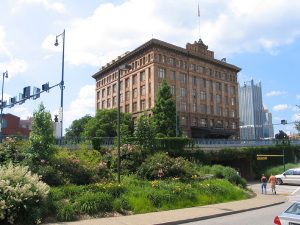
Featuring Architect William George Burns
 This is the best preserved of the large Pittsburgh railway stations still extant [containing] some 80,000 feet of floor space. . . . Designed in 1898 by William George Burns, it was completed in 1901. . . . On the interior the great waiting room is undoubtedly, after the foyer of the Carnegie Music Hall, the finest Edwardian space extant in Pittsburgh. The staircase that descends into the room like a waterfall is especially noteworthy and the ornate detail that adorns this great two-story hall contributes a general air of subdued cruscating [sparkling] richness to the whole convoluted space. Every effort should be made to preserve this elegant structure. —— James D. Van Trump, Landmark Architecture of Allegheny County, Pennsylvania (1967)
This is the best preserved of the large Pittsburgh railway stations still extant [containing] some 80,000 feet of floor space. . . . Designed in 1898 by William George Burns, it was completed in 1901. . . . On the interior the great waiting room is undoubtedly, after the foyer of the Carnegie Music Hall, the finest Edwardian space extant in Pittsburgh. The staircase that descends into the room like a waterfall is especially noteworthy and the ornate detail that adorns this great two-story hall contributes a general air of subdued cruscating [sparkling] richness to the whole convoluted space. Every effort should be made to preserve this elegant structure. —— James D. Van Trump, Landmark Architecture of Allegheny County, Pennsylvania (1967)
By Albert M. Tannler
PHLF Historical Collections Director
In the main, William George Burns should be considered a Canadian architect. He was born in Toronto, Canada, on either August 1, 1870 (according to Biographical Dictionary of Architects in Canada 1850-1950 (2009-2016) or in July 1871 (according to US Federal Census 1900), worked as a carpenter in Toronto in 1887, worked as an apprentice to architect Mancel Willmot (1853-1934) from 1888-1892 and subsequently worked as a draftsman for architect William G. Storm (1826-1892).
Burns came to America either in 1892 (according to the 1900 Federal Census) or in 1895 (according to Biographical Dictionary of Architects in Canada 1800-1950) which states “He left Canada in 1895 and went to New York City where he obtained further education before moving to Pittsburgh, Penn.” Burns’ work in Pittsburgh has been documented and spans 1898-1904. He first appears in Pittsburgh directories in 1899 in two entries: Wm G. Burns is listed as a draftsman, living at 12 Stockton Avenue, Allegheny, while G. W. Burns, architect, appears at the same address. He resided in Allegheny (1899), Beaver (1900), and Sewickley (1901-04). In 1901 Burns formed a partnership with Charles H. Craig and Harvey Childs Hodgens in the firm of Craig, Hodgens & Burns (1901-02), later Hodgens & Burns (1903-04).
Three of Burns’ projects in Western Pennsylvania have been documented: the Lincoln Hotel, (demolished); the John Snyder residence, Beaver, Pa., 1901; and the first and most important: the P&LE RR Station in Pittsburgh, 1898-1901.
Biographical Dictionary of Architects in Canada 1800-1950 notes that Burns “was fortunate enough to obtain a position as Staff Architect for the Pittsburgh & Lake Erie Rail Road in 1899 and was given the opportunity to design the P. & L.E. Railroad Station, Smithfield Street at Carson Street, PITTSBURGH, PENN., 1898-1901. . . . The significant Beaux-Arts landmark integrated commercial offices, passenger arrival and departure halls, and train sheds into one complex, and the Grand Concourse is now considered one of the finest interior public spaces in Pittsburgh.” The waiting room was decorated by Crossman & Sturdy, 287 Michigan Ave., a Chicago firm established in 1893. Their design for the P.&L.E. waiting room was published in the 1900 and 1903 Pittsburgh Architectural Club Exhibition catalogs.
Around 1905 Burns returned to Toronto and opened his own architecture practice. Among his documented works between 1905 and 1916 are nine houses (including his own); two churches and a Sunday school; and a factory. He left the architectural profession after 1922 and worked in real estate and construction before retiring. He died on November 23, 1949.
